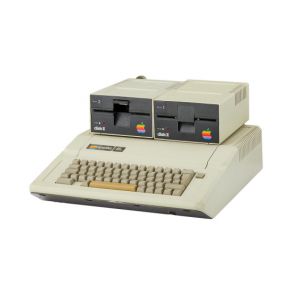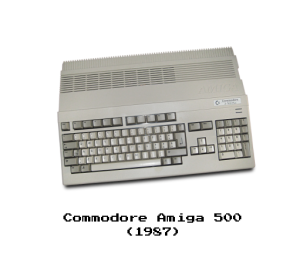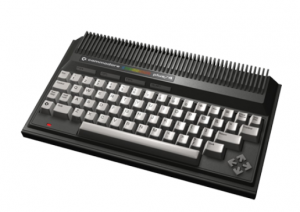A computer icon from the 1970s
In early 1977, the personal computer market was at the very beginnings of what would become a vast industry. In that year, two machines now often cited as pioneers of the home-/personal-computer era were released: the Apple II in June 1977 (by Apple Computer Inc.) and the TRS-80 (by Tandy Corporation under its Radio Shack brand) in August/September 1977. Around the same time, another important machine emerged: the Commodore PET.
The year 1977: Apple II and TRS-80
In June 1977, Apple introduced the Apple II, designed by Steve Wozniak and further marketed by Steve Jobs and the company. A few months later, on August 3, 1977, Radio Shack announced the TRS-80 Model I; sales began in September and quickly surpassed early expectations. These machines are often grouped together along with the Commodore PET as the “1977 trinity” of early home/personal microcomputers. That year marked a turning point: from hobby kits and industrial/micro‐controller systems, to machines marketed directly to education, home and small-business use.
The Commodore PET (whose name officially stood for “Personal Electronic Transactor”) was produced by Commodore International. According to multiple sources, development of the PET began in 1976, and it was first publicly demonstrated at the January 1977 Winter Consumer Electronics Show (CES) in Chicago. The PET was shipped to early customers later in 1977; many sources note that the first hundred units were shipped in mid‐October 1977, though general consumer availability came in December 1977. Thus, technically the PET preceded or at least overlapped the Apple II and TRS-80 in being introduced to the market. The machine’s hardware was built around the MOS Technology 6502 microprocessor running at about 1 MHz. The PET series included built-in monitor (initially a 9″ monochrome screen), keyboard, and early models included an integrated cassette tape deck for storage. The fact that Commodore already owned a steel‐cabinet manufacturing operation and the case of the PET was a welded metal chassis helped shape the PET’s distinctive all-in-one enclosure design.

Commodore PET 3032 in operation at the I love 8-bit® exhibition 2023
From the standpoint of 1977–1978, the PET offered one of the few truly self-contained personal computers: plug it in, power it up, and you had a keyboard, screen, BASIC interpreter and storage (cassette). The inclusion of a full BASIC interpreter in ROM, along with I/O ports and expansion sockets, made the PET a solid platform for education, small business, hobbyist programming, and research. Given its integrated design and early positioning, a user who wanted to learn programming, develop simple applications, or even explore computer‐graphics or data-processing at a desktop rather than in a lab would find the PET appealing. Moreover, because it was built by Commodore—a company that already had experience in calculators and industrial electronics—it offered somewhat more polish and readiness than the raw kit computers common in earlier years. In education markets especially, the PET found use thanks to its built-in display and keyboard (no need for separate television or extra peripherals) and a robust metal case that could stand up to classroom use. For small business deployments, the PET’s IEEE-488 (GPIB-style) parallel port (on later models) enabled daisy-chaining of peripherals like disk drives and printers, making it suitable for data entry, bookkeeping or controlled automation tasks.
Users might have wanted a PET for learning to program in BASIC or machine language on a ready-to-go computer, running software (e.g., business spreadsheets, word-processing, educational software), using it in a classroom or lab environment as a teaching computer and integrating with peripherals and data acquisition for real‐world control or hobby electronics (via its user port, parallel ports, etc.). In short: it was among the first machines that turned the idea of “desktop computer” from a hobbyist board into a commercially packaged product you could buy and use without extensive hardware-assembly.
Contemporary reviews and commentary on the PET noted both its innovation and some of its early limitations. For example, a review in Popular Science of the PET 2001 pointed out that the machine was advertised at US $495 (for the 4 KB version) but due to demand and cost constraints the price quickly rose. The machine’s integrated design and delivery ready “out-of-the-box” nature were praised. However reviewers also noted that early models had the so-called “chiclet” keyboard (small rubber‐style keys shaped like chewing‐gum “Chiclets”), which many users found awkward for touch typing. The small built-in screen (9″) and monochrome display were sometimes seen as minimal relative to later machines, but at the time they were acceptable given the price and the novelty of full-computer in one unit. The Smithsonian description of the PET notes that “Users could write their own programs in BASIC, but many complained about the small keyboard … the screen … was small …” On the other hand, the fact that the PET aimed for a fully integrated package (processor, display, keyboard, storage) made it much more user-friendly than many microcomputer kits of the era. It also laid the groundwork for what a home or small-business computer could look like.
The role of Microsoft Corporation (and co-founder Bill Gates) in the PET story comes via the BASIC interpreter: the PET used a variant of Microsoft’s 6502-based BASIC interpreter. According to sources, Commodore licensed Microsoft’s 6502 BASIC; Microsoft supplied the source listing for their 6502 BASIC (a port of BASIC-80) and Commodore adapted it (adding startup screen, prompts, I/O support, SYS command, bug fixes). Indeed, an interesting anecdote: if one types the command WAIT6502,1 on a PET with BASIC V2, the screen will display “MICROSOFT!” in the top left corner — allegedly added by Bill Gates himself after a dispute with Commodore founder Jack Tramiel, to assert that the BASIC came from Microsoft. Thus Microsoft’s involvement helped accelerate the PET’s ability to ship with a high‐quality BASIC interpreter, reducing one of the major burdens for computer manufacturers at that time (i.e., creating a language environment). Commodore, led by Jack Tramiel, purchased the BASIC interpreter from Microsoft for a one-time payment of $25,000, which was a good deal for Commodore, as tens of millions of Commodore computers were sold with the Microsoft program included as a one-time payment. Bill Gates decided to stop selling programs to computer manufacturers and instead sell software licenses. As is well known, IBM licensed Microsoft’s operating system for the IBM PC, which led to Microsoft becoming one of the world’s most valuable companies. Commodore was unable to repeat the success it had achieved in the 1980s, but Microsoft’s licensing-based business model allowed anyone to manufacture a PC with a compatible operating system. This proved fatal for other computer manufacturers. Only Apple survived, and even it needed Microsoft’s help in the 1990s.
As for how many PET units were sold, the best-supported number is approximately 219,000 units globally (across all PET models) before the line was discontinued. Some other sources offer lower numbers or estimates (for example over 50,000 units) but the 219,000 figure is widely cited. The machine line was discontinued circa 1982. By that time, competition from more powerful systems (including Commodore’s own subsequent machines) and falling demand for the PET all-in-one format led Commodore to move on. The PET’s educational market presence remained strong for some time, but ultimately the platform was superseded by later machines.
From a historical perspective, the Commodore PET is significant because it was among the earliest fully assembled personal computers marketed to a broad audience—and it predated or at least was contemporaneous with the Apple II and TRS-80 in 1977. Its integrated “box” with keyboard, screen and storage simplified the computer experience for educators, hobbyists and small business users. That packaging concept would become the norm in later personal computing. Its use of the MOS 6502 processor, integration of BASIC in ROM, and incorporation of expansion ports made it a flexible platform. Through licensing Microsoft’s BASIC and adapting it, it also exemplified the early software-hardware partnerships which became standard in the microcomputer industry. The PET line also laid the groundwork for Commodore’s later success (such as the famed Commodore 64 in 1982) and helped commoditise personal computing hardware. For someone in 1977 or 1978 considering a PET, the purchase made sense if they were serious about programming, needed a dedicated computer rather than a kit, or were in education or business environments where integrated hardware reduced setup complexity. The PET offered a relatively robust platform, backed by a known manufacturer, with support for such tasks — something many other microcomputers of the time did not provide in such an all-in-one package.

I love 8-bit® and Commodore PET in operation at the Assembly Summer party 2022 in Helsinki.





























